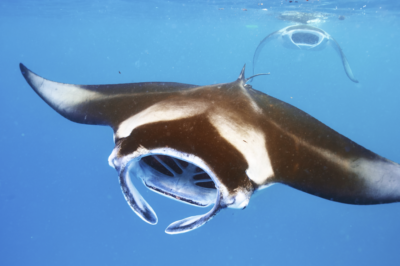By Silvia Sanchez Bor, April 11, 2016
The park rangers at Isla de la Plata, a part of Ecuador’s Machalilla National Park, now have increased protection for their waters. Nicknamed “Little Galapagos” by the locals, the uninhabited island off the mainland coast is home to five species of sea turtles, 20 species of whales and dolphins, hammerhead and whale sharks, and countless species of fish, corals and mollusks. It’s also home to the largest population of Giant Manta Rays (Manta birostris), estimated at 1,500 individuals.
Ecuador’s marine biodiversity is important not only for the health of the ocean, but also for the nation’s fishing and tourism industries. In a recent study, we estimated the value of manta tourism at approximately $140 million worldwide.
However, small-scale and commercial fishers frequently engage in illegal fishing that threatens mantas and the health of the marine environment. Trawl and long-line fishing, both popular in Ecuador, affect endangered sharks, sea birds and sea turtles. Unsustainable fishing methods also kill thousands of mantas around the world each year when caught as bycatch.
This month, WildAid and Conservation International achieved an important milestone in real-time monitoring of Ecuador’s marine environment with the installation of a long-range surveillance camera and real-time monitoring software (AIS) on Isla de la Plata. The long-range camera and AIS surveillance are part of a comprehensive marine protection plan that will help park authorities prevent illegal fishing in the area, helping to protect its abundant marine ecosystems.
Electronic surveillance tools provide park rangers with a more cost effective way to identify illegal vessels in the area, and quickly send their patrol boats to apprehend them. Video footage and AIS tracking are also great sources of evidence in environmental trials to ensure that illegal fishers can be fined and sentenced for their actions.
WildAid has already used tools such as these to help park rangers capture and sentence more than 100 industrial and small-scale fishing vessels in the Galapagos, such as the Fer Mary I that was caught with 350 illegally caught sharks in its hold. This system, which will be installed on Santa Clara Island later this year, will be tested on Isla de la Plata to evaluate its effectiveness for monitoring the larger coast of Ecuador.
This work is part of a three-year project in six MPAs in Ecuador to reduce illegal and unsustainable fishing. Our work includes a comprehensive marine protection plan for each site, regular patrols, training for rangers and fisher/ community outreach.
